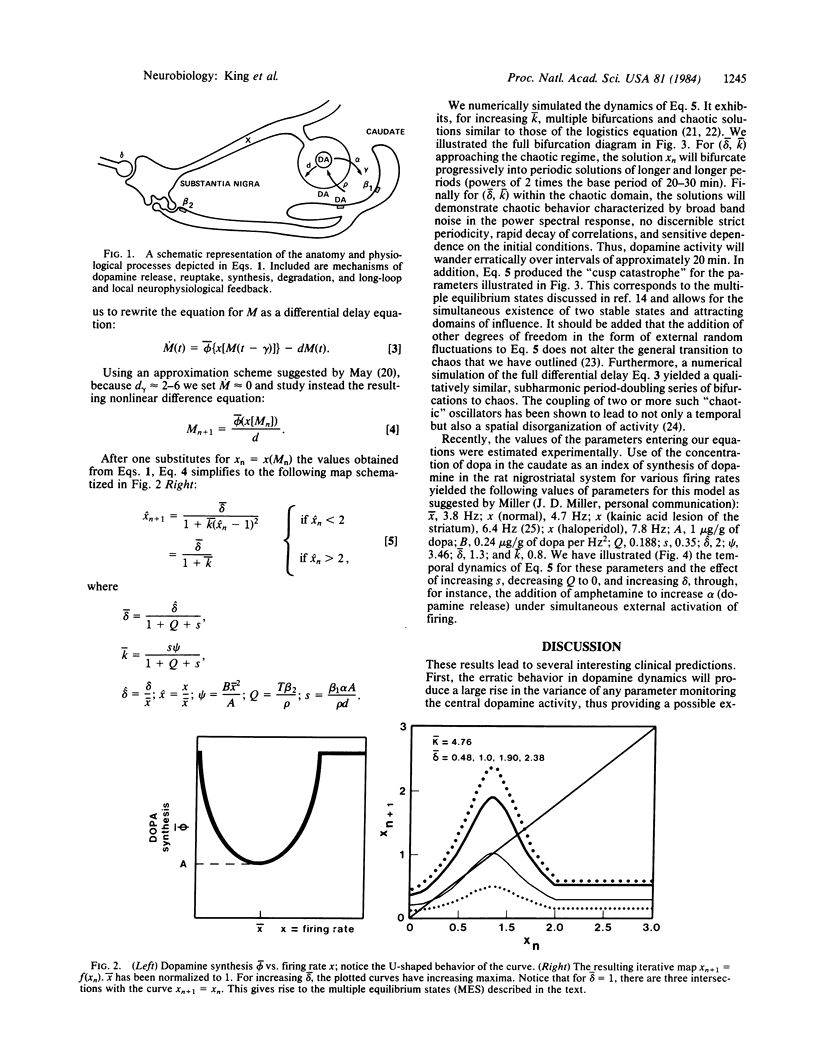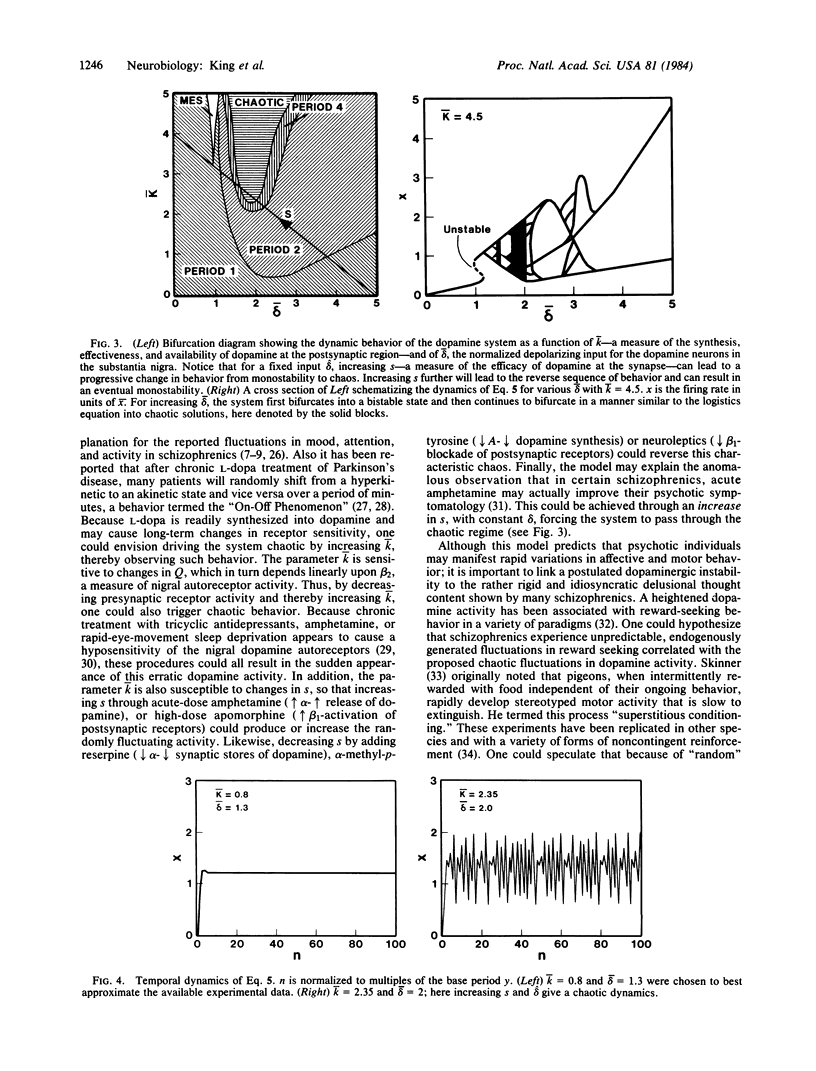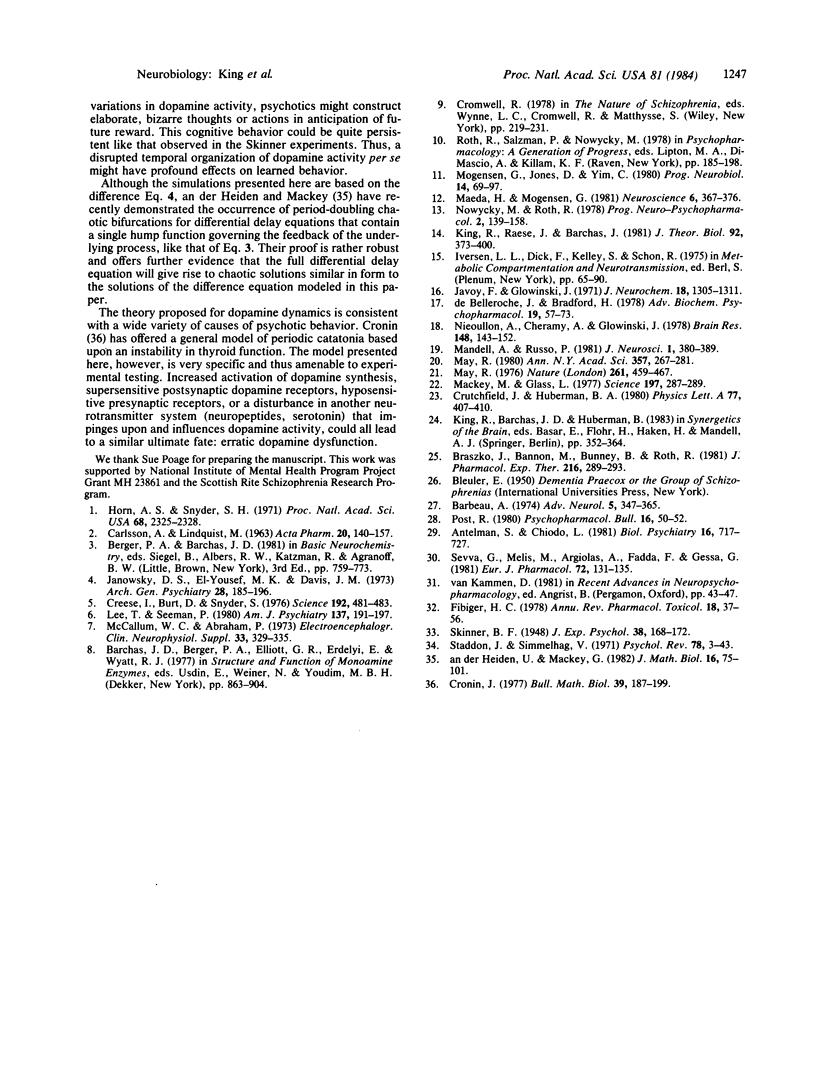Abstract
We report the results of the dynamics of a model of the central dopaminergic neuronal system. In particular, for certain values of a parameter k, which monitors the efficacy of dopamine at the postsynaptic receptor, chaotic solutions of the dynamical equations appear--a prediction that correlates with the observed increased variability in behavior among schizophrenics, the rapid fluctuations in motor activity among Parkinsonian patients treated chronically with L-dopa, and the lability of mood in some patients with an affective disorder. Moreover our hypothesis offers specific results concerning the appearance or disappearance of erratic solutions as a function of k and the external input to the dopamine neuronal system.
Full text
PDF



Selected References
These references are in PubMed. This may not be the complete list of references from this article.
- Antelman S. M., Chiodo L. A. Dopamine autoreceptor subsensitivity: a mechanism common to the treatment of depression and the induction of amphetamine psychosis. Biol Psychiatry. 1981 Aug;16(8):717–727. [PubMed] [Google Scholar]
- Barbeau A. The clinical physiology of side effects in long-term L-DOPA therapy. Adv Neurol. 1974;5:347–365. [PubMed] [Google Scholar]
- Braszko J. J., Bannon M. J., Bunney B. S., Roth R. H. Intrastriatal kainic acid: acute effects on electrophysiological and biochemical measures of nigrostriatal dopaminergic activity. J Pharmacol Exp Ther. 1981 Feb;216(2):289–293. [PubMed] [Google Scholar]
- Creese I., Burt D. R., Snyder S. H. Dopamine receptor binding predicts clinical and pharmacological potencies of antischizophrenic drugs. Science. 1976 Apr 30;192(4238):481–483. doi: 10.1126/science.3854. [DOI] [PubMed] [Google Scholar]
- Cronin J. Mathematical aspects of periodic catatonic schizophrenia. Bull Math Biol. 1977;39(2):187–199. doi: 10.1007/BF02462858. [DOI] [PubMed] [Google Scholar]
- Fibiger H. C. Drugs and reinforcement mechanisms: a critical review of the catecholamine theory. Annu Rev Pharmacol Toxicol. 1978;18:37–56. doi: 10.1146/annurev.pa.18.040178.000345. [DOI] [PubMed] [Google Scholar]
- Horn A. S., Snyder S. H. Chlorpromazine and dopamine: conformational similarities that correlate with the antischizophrenic activity of phenothiazine drugs. Proc Natl Acad Sci U S A. 1971 Oct;68(10):2325–2328. doi: 10.1073/pnas.68.10.2325. [DOI] [PMC free article] [PubMed] [Google Scholar]
- Janowsky D. S., el-Yousel M. K., Davis J. M., Sekerke H. J. Provocation of schizophrenic symptoms by intravenous administration of methylphenidate. Arch Gen Psychiatry. 1973 Feb;28(2):185–191. doi: 10.1001/archpsyc.1973.01750320023004. [DOI] [PubMed] [Google Scholar]
- Javoy F., Glowinski J. Dynamic characteristic of the 'functional compartment' of dopamine in dopaminergic terminals of the rat striatum. J Neurochem. 1971 Jul;18(7):1305–1311. doi: 10.1111/j.1471-4159.1971.tb00230.x. [DOI] [PubMed] [Google Scholar]
- King R., Raese J. D., Barchas J. D. Catastrophe theory of dopaminergic transmission: a revised dopamine hypothesis of schizophrenia. J Theor Biol. 1981 Oct 21;92(4):373–400. doi: 10.1016/0022-5193(81)90255-1. [DOI] [PubMed] [Google Scholar]
- Lee T., Seeman P. Elevation of brain neuroleptic/dopamine receptors in schizophrenia. Am J Psychiatry. 1980 Feb;137(2):191–197. doi: 10.1176/ajp.137.2.191. [DOI] [PubMed] [Google Scholar]
- Mackey M. C., Glass L. Oscillation and chaos in physiological control systems. Science. 1977 Jul 15;197(4300):287–289. doi: 10.1126/science.267326. [DOI] [PubMed] [Google Scholar]
- Maeda H., Mogenson G. J. Electrophysiological responses of neurons of the ventral tegmental area to electrical stimulation of amygdala and lateral septum. Neuroscience. 1981;6(3):367–376. doi: 10.1016/0306-4522(81)90130-5. [DOI] [PubMed] [Google Scholar]
- Mandell A. J., Russo P. V. Striatal tyrosine hydroxylase activity: multiple conformational kinetic oscillators and product concentration frequencies. J Neurosci. 1981 Apr;1(4):380–389. doi: 10.1523/JNEUROSCI.01-04-00380.1981. [DOI] [PMC free article] [PubMed] [Google Scholar]
- May R. M. Simple mathematical models with very complicated dynamics. Nature. 1976 Jun 10;261(5560):459–467. doi: 10.1038/261459a0. [DOI] [PubMed] [Google Scholar]
- Mogenson G. J., Jones D. L., Yim C. Y. From motivation to action: functional interface between the limbic system and the motor system. Prog Neurobiol. 1980;14(2-3):69–97. doi: 10.1016/0301-0082(80)90018-0. [DOI] [PubMed] [Google Scholar]
- Nieoullon A., Cheramy A., Glowinski J. Release of dopamine in both caudate nuclei and both substantia nigrae in response to unilateral stimulation of cerebellar nuclei in the cat. Brain Res. 1978 Jun 9;148(1):143–152. doi: 10.1016/0006-8993(78)90384-0. [DOI] [PubMed] [Google Scholar]
- Post R. M. Sensitization and oscillation following repeated stimulation: relationship to affective illness and its treatment with lithium and carbamazepine [proceedings]. Psychopharmacol Bull. 1980 Oct;16(4):50–52. [PubMed] [Google Scholar]
- Serra G., Melis M. R., Argiolas A., Fadda F., Gessa G. L. REM sleep deprivation induces subsensitivity of dopamine receptors mediating sedation in rats. Eur J Pharmacol. 1981 Jun 10;72(1):131–135. doi: 10.1016/0014-2999(81)90310-1. [DOI] [PubMed] [Google Scholar]
- de Belleroche J. S., Bradford H. F. Compartmentation of synaptosomal dopamine. Adv Biochem Psychopharmacol. 1978;19:57–73. [PubMed] [Google Scholar]


